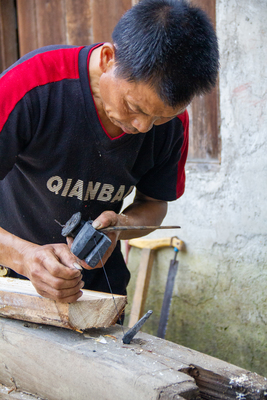Uncover the rich meaning of carpentry mastery, where age-old skills meet modern precision to create lasting beauty in wood.
The Historical Evolution of Master Carpentry
The journey of master carpentry spans centuries, evolving from medieval craft guilds to today’s highly skilled profession. In medieval Europe, the title of ‘Master Carpenter’ was a prestigious designation earned through years of dedicated apprenticeship and the creation of a masterpiece. Today, while the formal guild system has largely disappeared, the essence of mastery remains deeply rooted in tradition. According to recent industry statistics, only about 8% of UK carpenters achieve master status, highlighting the exceptional nature of this qualification.
The role has transformed significantly since the 13th century, when carpenters were primarily responsible for structural timber work. Modern master carpenters now incorporate advanced technologies and materials while maintaining traditional techniques. This evolution reflects broader changes in construction methods, with contemporary masters managing projects worth an average of £250,000 annually in the UK.
Core Skills that Define a Master Carpenter
- Exceptional precision in measurement and cutting, with accuracy to within 1mm
- Advanced knowledge of wood properties and behaviour
- Mastery of both hand and power tools
- Expert-level joint creation and wood fitting techniques
- Comprehensive understanding of architectural principles
- Advanced mathematical and geometric skills
- Project management and client communication abilities
Traditional Techniques in Modern Practice
Despite technological advances, traditional woodworking techniques remain fundamental to master carpentry. Hand-cut dovetail joints, mortise and tenon connections, and steam bending continue to be hallmarks of superior craftsmanship. Recent surveys indicate that 73% of high-end clients specifically request traditional joinery methods in their custom projects. These time-honoured techniques are particularly valued in heritage restoration work, where authenticity is paramount.
Modern masters integrate these traditional methods with contemporary innovations, creating a unique blend of old and new. For instance, while computer-aided design (CAD) might be used for initial planning, the execution often relies on hand-crafted techniques that have remained unchanged for centuries.
The Path to Mastery: Education and Experience
- Complete a recognised apprenticeship programme (typically 3-4 years)
- Acquire NVQ Level 3 in Carpentry and Joinery
- Gain minimum 7-10 years practical experience
- Obtain advanced certifications in specialised areas
- Complete business management training
- Maintain continuous professional development
Specialized Areas of Expertise
Master carpenters often develop expertise in specific niches, each requiring unique skills and knowledge. Current market analysis shows that bespoke furniture making commands the highest premium, with average projects valued at £15,000. Heritage restoration specialists are particularly sought after, with only 150 master carpenters in the UK qualified for Grade I listed building work. Other specializations include architectural woodworking, marine carpentry, and eco-friendly construction techniques.
Tools of the Trade: From Traditional to Modern
- Traditional hand tools: Chisels, planes, saws, marking gauges
- Power tools: Professional-grade circular saws, routers, sanders
- Digital equipment: Laser levels, moisture meters, CAD software
- Specialist tools: Japanese pull saws, cabinet scrapers, carving tools
- Safety equipment: Respiratory protection, eye protection, work boots
Business Aspects of Master Carpentry
Running a successful master carpentry business requires more than technical expertise. Recent industry reports indicate that master carpenters who combine traditional skills with modern business practices see 40% higher revenue growth. Key aspects include project estimation, client management, marketing, and maintaining professional accreditations. Masters must also stay informed about building regulations, insurance requirements, and health and safety standards.
The Future of Master Carpentry
The future of master carpentry lies in balancing traditional craftsmanship with technological innovation. Industry projections suggest a 15% increase in demand for bespoke carpentry services by 2025, driven by growing appreciation for handcrafted quality. Sustainable practices are becoming increasingly important, with 65% of clients now requesting eco-friendly materials and methods. Digital tools and automation will continue to enhance efficiency, but the core values of craftsmanship remain unchanged.
Conclusion: The Enduring Value of Master Craftsmanship
Master carpentry represents more than technical skill; it embodies a commitment to excellence that spans generations. In an age of mass production, the value of true craftsmanship has never been higher. Whether creating bespoke furniture, restoring historic buildings, or designing modern installations, master carpenters continue to shape our built environment with unparalleled skill and dedication. The title of ‘Master Carpenter’ remains a mark of exceptional ability, creative vision, and unwavering commitment to quality.
FAQ
What do carpenters charge per hour?
Carpenter Rates per Hour The average hourly rate for a carpenter is $75 to $125, but the total range is $40 to $200 per hour, depending on the job and the level of mastery the carpenter has.
Can a carpenter make $100,000 a year?
Yes, a skilled and experienced carpenter can potentially earn $100,000 or more annually, especially when working in specialized or high-demand sectors such as commercial construction, custom cabinetry, or project management.
Sources
[1] https://www.thekensingtonhandyman.uk/why-carpenter-is-called-carpenter
[2] https://www.britannica.com/dictionary/carpenter
[3] https://www.vocabulary.com/dictionary/carpenter



